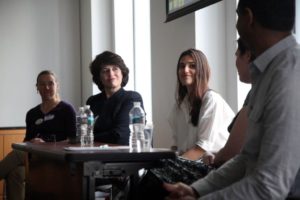
By Alex Brubaker
Science at its core is our natural curiosity about the world around us. One could say it’s our birthright. However, the current state of knowledge of, and enthusiasm for, science in the United States is troubling. Only about one third of adults understand what science is and how the scientific method works, said Kristin Erickson of NASA. Studies show that most young school-age children are interested in science, but that for many of them, that interest declines as they get older. So how can we as science communicators help arrest this decline? How can we prevent today’s intrigued children from becoming tomorrow’s ignorant and turned-off adults?
Each member of the panel of all-star science communicators convened to discuss the issue for “The impressionables: Science communication to engage children and teens” at Professional Development Day 2017 had a distinct perspective on how to reach youth, but all could agree on key points. Connect, inspire, fascinate, visualize, make them active learners, and whatever else, don’t dumb it down.
Hakeem Oluseyi of NASA emphasized “it’s all about connection” and that relating to youth at their level is important for science communication to take hold. It’s important to talk to the kids if that’s your target audience, not to your colleagues. Erickson observed that sometimes scientists can “go gray” in front of the cameras, inadvertently coming across as lifeless and boring. On the other hand, when a scientist shares their “aha” moment in a way the audience can relate to, “there’s nothing like it!”
As far as the nuts and bolts of how to present science to kids, the use of visuals, videos, or games can go a long way. Games can incorporate “stealthy teaching,” Oluyesi said, citing the hours of fun his son has playing ExoTreks while learning tons in the process. Making kids active learners is an improvement over an outdated approach to learning that overemphasized rote memorization and passive ingestion of knowledge.
As exciting as multimedia may be, there will likely always be a place for the (well)-written word. How best to write for a young audience? “We take real news from Science News and explain it really, really well,” said Sarah Zielinski of Science News for Students. Often, the story will get longer. Science News for Students can’t leave logical holes or expect a 12-year old to make the same logical leap you’d expect an adult to, Zielinski said. Ariane Szu-Tu of National Geographic Kids Publishing agreed. “You can’t assume that kids have the same knowledge base,” she said.
Zany fun facts that kids can read at home and then share with peers at recess are a big hit, with 6 million copies sold in the Nat Geo Kids “Weird but True” series, Szu-Tu said. Panelists concurred that there’s no need to dumb things down if you’re doing a great job explaining the big picture, that it’s counterproductive when authors dumb things down so much they become inaccurate, and that writing for kids makes one a better writer overall.
Oluyesi desribed how he was approached by a student who went back to school after being homeless for a time, working 2 jobs to cover tuition. She said she knows she can do it because he believed in her, and she’s not giving up.
“A lot of people live in a state of hopelessness, you don’t need to stay in hopelessness . . . when someone starts paying attention and saying you’re smart and you can do it, that can make all the difference,” Oluyesi said.

Sorry, comments are closed for this post.